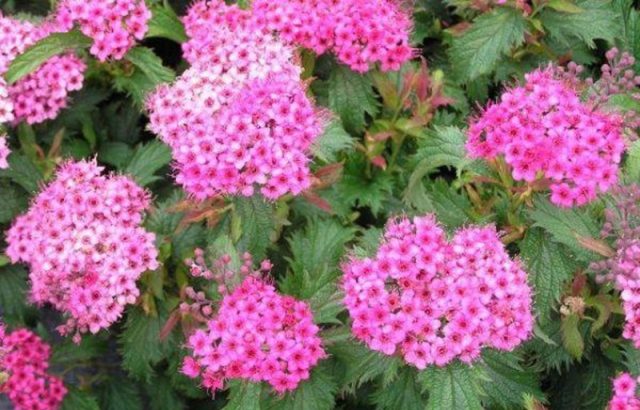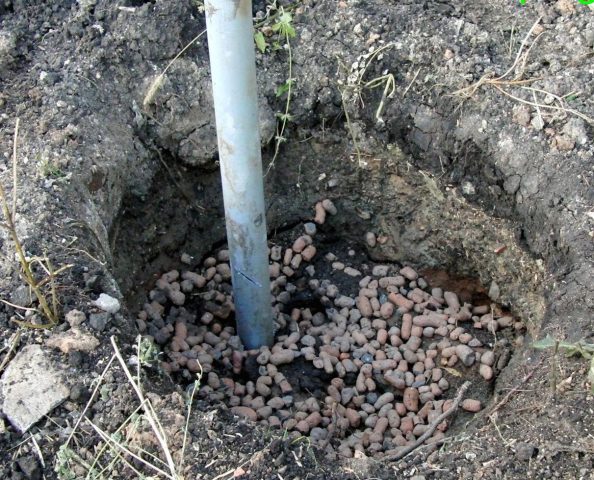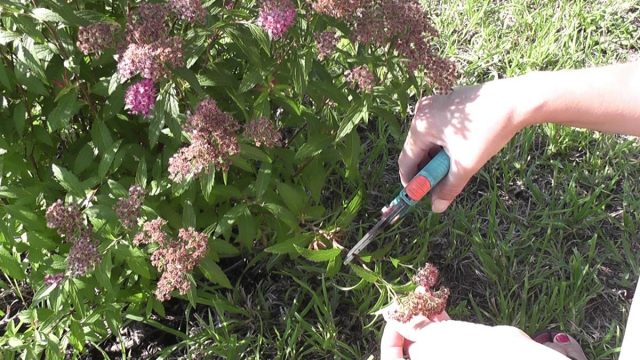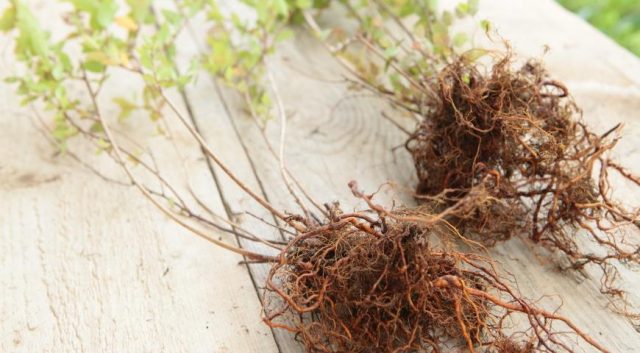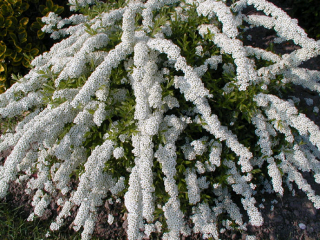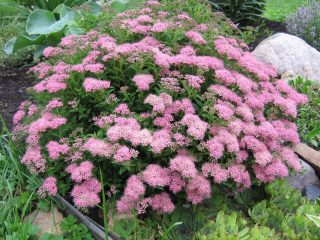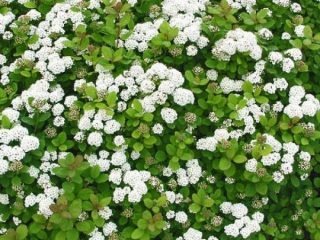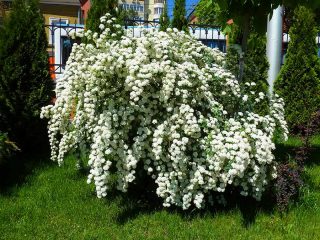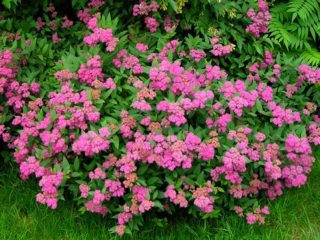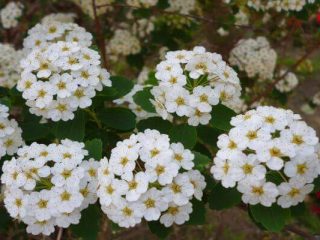Content
Many lovers of ornamental gardening are familiar with Japanese spirea Crispa - a low, compact, round-shaped shrub. This is one of the few plants that combines a lot of positive qualities: excellent appearance, long flowering period, lightness and low maintenance. In addition, the shrub has good frost resistance, which allows it to be grown in various regions of the country.
Description of Spiraea Crispus
Japanese spirea Crispa (pictured below) is a small shrub with a dense, cap-shaped crown. It is a decorative form of Japanese spirea - a perennial deciduous shrub of the Rosaceae family, growing in China, Korea and Japan.
The main characteristics and description of Japanese Crispa spirea are presented in the table.
Parameter | Meaning |
Plant type | Deciduous shrub |
Height of an adult bush | Up to 0.6 m |
Crown diameter | Up to 0.8 m |
Escapes | Erect, sinewy, freely branching |
Leaves | Young leaves are reddish, later dark green; in autumn the color changes to scarlet or orange with a bronze tint. The leaf blade is wavy, deeply cut, ovoid |
Flowers | They appear on shoots after 2 years of life. Collected in lush simple umbrellas with a diameter of up to 5.5 cm, delicate mauve color |
Flowering duration | 1.5-2 months (July-August) |
Purpose | Decorative gardening, landscape design |
Spiraea japonica Crispa in landscape design
Thanks to its compact size, dense rounded crown and long flowering, Japanese Crispa spirea has found wide use in landscape design. It is planted both in single and group plantings. Often a flowering bush is used as a color accent, the central element of a flower bed, or a single plant when planted in containers or flowerpots.
In group plantings, Crispa spirea is effective in mixboards, mixed plantings, as an element of the design of paths and alleys, as one of the steps of a multi-level or low separate hedge.
Planting and caring for Crispa spirea
It is best to plant this ornamental shrub in open ground in spring or autumn, and if the seedling has a closed root system, then in summer. Planting and caring for the Japanese Crispa spirea is simple and will not cause any difficulties even for beginners.
Preparation of planting material and site
It is advisable to purchase planting material in specialized stores or nurseries. Sometimes seedlings of this plant can be found there under the name Spiraea curly Crispa. They are usually sold in special planting containers filled with soil. Often there are seedlings with roots coated with clay mortar. If the root system is open, it must be inspected.A spirea seedling suitable for planting must have a significant number of thin, long roots - lobes, as well as healthy, strong tap roots without signs of rot.
Spiraea Japanese Crispa grows well in open, well-lit areas; it can also be planted in light partial shade. The plant is unpretentious in terms of soil composition and grows on both slightly acidic and slightly alkaline soils. However, it is desirable that the acidity be close to neutral, so gardeners often make planting holes of increased size, filling them after planting with pre-prepared soil with an optimal pH level.
The planting hole is made in advance, usually 1/3 larger than the size of the root system. A layer of drainage made from fragments of brick or crushed stone is laid on its bottom.
Planting Spiraea Crispus
It is best to plant Japanese spirea Crispa in open ground on a rainy, cloudy day. Before planting, the container with the seedling is spilled generously with water. This will make it easier to remove. The plant is planted in a planting hole along with a lump of earth. Exposed roots must first be straightened out. Then the hole is covered with earth so that the root collar of the bush is flush with the surface of the earth. Then the Crispa spirea seedlings are cut by about 1/3, after which abundant watering is carried out, and the root zone is mulched with peat.
Watering and fertilizing
In most cases, precipitation is sufficient for Japanese Crispa spirea to feel good and grow without any problems.During dry periods, you can make an exception and water the root zone at the rate of 1 bucket per bush.
If the land on the site is sufficiently fertile, there is also no need to feed the spirea. If the soil is poor, you can use mineral fertilizers applied to the tree trunk. In the spring, this is any nitrogen-containing substance, for example, nitrophoska, in the summer, potassium-phosphorus fertilizers for abundant flowering, and in the fall, superphosphate for better preparation for winter. Many gardeners use special complex formulations, such as Kemira-Universal, applying them once per season, in early spring.
Trimming
Spiraea Crispa tolerates pruning well. To ensure that the bush always has a neat appearance, it is recommended to regularly do sanitary pruning, cutting out dried or damaged shoots. In addition, there are several other types of shrub pruning:
- stimulating;
- formative;
- rejuvenating.
You can start pruning Crispa spirea bushes 3-4 years after planting. Stimulating pruning is carried out to increase the density of the bush and compact its crown. To do this, lignified shoots are pruned in early spring at a height of 20–25 cm from the ground. This bush will begin to bloom in July. If stimulating pruning is not done, the bush will bloom earlier - in June. In this case, it is advisable to remove faded inflorescences without waiting for the seeds to ripen. This measure promotes re-blooming of the shrub in September if the weather is warm enough.
Formative pruning of Crispa spirea involves giving the crown of the bush a certain geometric shape (most often a regular hemisphere) and further pruning shoots that extend beyond its dimensions.
Sufficiently old bushes of Crispa spirea may require rejuvenating pruning. With this procedure, the bush is simply cut at ground level. The buds remaining in the area of the root collar will begin to grow in the spring, and thus a new bush will form on the existing root system.
Preparing for winter
The winter hardiness of Crispa spirea is very high. In the middle zone, the bush can easily winter without any shelter. Most gardeners do not take any measures to prepare for winter, but to be more sure, in the pre-winter period it is advisable to mulch the root zone with a thick layer of peat, bark or sawdust, and then simply cover the bush itself with snow.
Reproduction
Like most shrubs, Japanese spirea Crispa can be propagated by seed and vegetative methods. The seeds are collected 1.5-2 months after flowering so that they are fully ripe. The collected material is stratified, kept for several months at sub-zero temperatures. To do this, you can use any container that can be stored in the refrigerator or simply buried in the snow. In early spring, seeds are planted under film, and after 2-3 months the young plants are transplanted into a greenhouse for growing.
However, the seed method does not guarantee that a varietal plant will grow from a seed. When propagated by seeds, only species characteristics are preserved, while varietal characteristics may be lost. Therefore, Crispa spirea is often propagated by the following vegetative methods:
- cuttings;
- dividing the bush;
- layering from the mother bush.
Cuttings are an easy way to propagate spirea while maintaining all varietal characteristics. Cuttings are cut in September from the current year's shoots so that each has 5 leaves. The lower ones are removed, the top 2 leaves are cut in half. The finished planting material is placed with the lower cut in Epin's solution for 12 hours, then treated with Kornevin powder and planted in a container filled with damp sand. The cuttings are buried 2 cm at an angle of 45°. Then the container is covered with glass or film and placed in a warm place.
From time to time, spirea cuttings are ventilated, removing the cover, and also sprayed with water, keeping the sand moist. Rooting usually occurs within 1-2 months, after which young spirea seedlings are planted in separate containers.
Dividing a bush is a simple, but rather labor-intensive way to propagate Japanese spirea Crispa. This event usually takes place in September. A spirea bush at the age of 3-5 years is completely dug up and the soil is washed away from the roots with water pressure from a hose. Then, using garden pruners, the bush is divided into several parts - the so-called divisions. Each of them should have several well-developed shoots, taproots and fibrous roots.
The finished cuttings are planted in planting holes in the same sequence as during normal planting of seedlings.
Layerings can be obtained by bending a long side shoot of Crispa spirea to the ground and fixing it in this position. The contact area must be covered with earth. If you regularly water this area, the allocated shoot will quickly take root and send out its own sprout. In this position, the plant is left for the winter.In early spring, the cuttings can be separated from the mother shoot, dug up along with the roots and transplanted to a permanent place.
Diseases and pests
Diseases rarely attack Spiraea Crispus. Most often this happens on old, neglected bushes that have not received any care. Lack of pruning leads to a strong thickening of the internal space; impaired air exchange provokes increased humidity. In such conditions, fungi multiply rapidly, especially if the summer is cool and rainy. When signs of the disease appear, the affected shoots must be cut out and burned. You can stop the spread of the fungus by spraying the bush with a solution of any fungicide, for example, copper sulfate.
The most common pests that appear on Spira Crispus are aphids, leaf rollers and spider mites. You can get rid of them by spraying with special means. If detected early, it is sometimes possible to avoid this by simply tearing off the leaves along with the insects.
Conclusion
Japanese spirea Crispa is a beautiful and unpretentious shrub. You can decorate with it not only the garden, but also any local area: a flower bed near the entrance, a flower garden, a path in the garden. Excellent winter hardiness and minimal care requirements make planting this shrub doubly justified. And the long flowering period and beautiful appearance will satisfy even the most demanding gardener.
